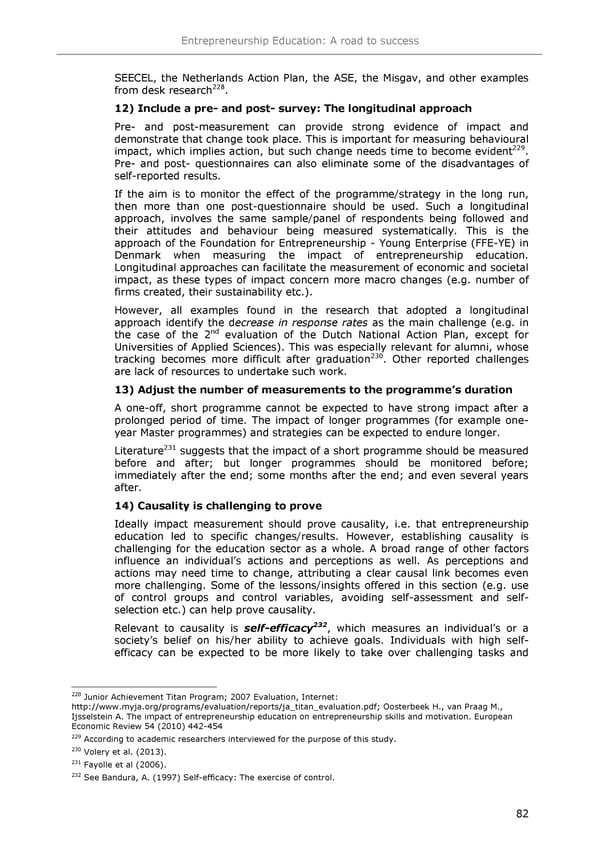Entrepreneurship Education: A road to success SEECEL, the Netherlands Action Plan, the ASE, the Misgav, and other examples 228 from desk research . 12) Include a pre- and post- survey: The longitudinal approach Pre- and post-measurement can provide strong evidence of impact and demonstrate that change took place. This is important for measuring behavioural 229 impact, which implies action, but such change needs time to become evident . Pre- and post- questionnaires can also eliminate some of the disadvantages of self-reported results. If the aim is to monitor the effect of the programme/strategy in the long run, then more than one post-questionnaire should be used. Such a longitudinal approach, involves the same sample/panel of respondents being followed and their attitudes and behaviour being measured systematically. This is the approach of the Foundation for Entrepreneurship - Young Enterprise (FFE-YE) in Denmark when measuring the impact of entrepreneurship education. Longitudinal approaches can facilitate the measurement of economic and societal impact, as these types of impact concern more macro changes (e.g. number of firms created, their sustainability etc.). However, all examples found in the research that adopted a longitudinal approach identify the decrease in response rates as the main challenge (e.g. in the case of the 2nd evaluation of the Dutch National Action Plan, except for Universities of Applied Sciences). This was especially relevant for alumni, whose tracking becomes more difficult after graduation230. Other reported challenges are lack of resources to undertake such work. 13) Adjust the number of measurements to the programme9s duration A one-off, short programme cannot be expected to have strong impact after a prolonged period of time. The impact of longer programmes (for example one- year Master programmes) and strategies can be expected to endure longer. 231 Literature suggests that the impact of a short programme should be measured before and after; but longer programmes should be monitored before; immediately after the end; some months after the end; and even several years after. 14) Causality is challenging to prove Ideally impact measurement should prove causality, i.e. that entrepreneurship education led to specific changes/results. However, establishing causality is challenging for the education sector as a whole. A broad range of other factors influence an individual9s actions and perceptions as well. As perceptions and actions may need time to change, attributing a clear causal link becomes even more challenging. Some of the lessons/insights offered in this section (e.g. use of control groups and control variables, avoiding self-assessment and self- selection etc.) can help prove causality. 232 Relevant to causality is self-efficacy , which measures an individual9s or a society9s belief on his/her ability to achieve goals. Individuals with high self- efficacy can be expected to be more likely to take over challenging tasks and 228 Junior Achievement Titan Program; 2007 Evaluation, Internet: http://www.myja.org/programs/evaluation/reports/ja_titan_evaluation.pdf; Oosterbeek H., van Praag M., Ijsselstein A. The impact of entrepreneurship education on entrepreneurship skills and motivation. European Economic Review 54 (2010) 442-454 229 According to academic researchers interviewed for the purpose of this study. 230 Volery et al. (2013). 231 Fayolle et al (2006). 232 See Bandura, A. (1997) Self-efficacy: The exercise of control. 82
 Entrepreneurship Education Page 85 Page 87
Entrepreneurship Education Page 85 Page 87